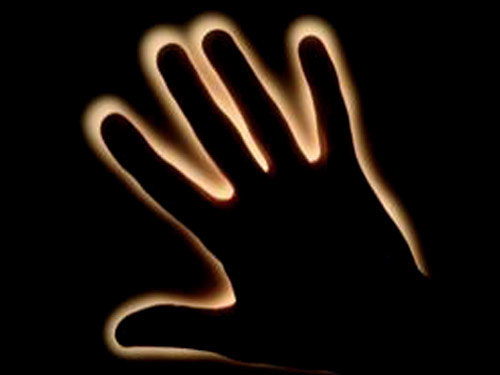The invisible hand
Have you ever wanted to know what an invisible hand looks like? It's a little bigger than the real one, but the fingers are shorter. At New Scientist's site, for the first time, the perceived shape of an imaginary arm was measured in size. This finding may help us know more about how the brain visualizes body parts.
The illusion of an invisible arm can occur after a amputation or in a person who has lost it due to congenital disease. As a result, the patient had the feeling that the arm actually existed. According to one hypothesis, the patient looked around to see what his body didn't look like. Another theory is that the feeling of an invisible arm reflects brain activity in areas of 'mapping' our bodies in space.

The invisible hand
In order to clarify the origins of the invisible arms, expert Matthew Longo of the University of London (UK) and colleagues thanks CL for help, a 38-year-old woman with congenital and frequent left hand amputation It feels like I have an invisible arm. She was asked to place her right hand under a board and point out where her fingertips were, where her knuckles were. Then she repeated with her left arm imagining.
Previous studies have shown that we tend to judge the wrong finger length, gradually increasing from thumb to pinkie. This reflects the difference in the degree of sensation and size of the cortex that governs the sense of touch (somatosensory cortex), which is supposed to help us visualize each finger. As predicted by the researchers, CL reported on these characteristic distortions when pointing out the dimensions of the right hand. But she still made the same mistake when describing the invisible arm, showing that she felt both hands in the same way.
This confirms 'a certain structural representation in the brain about a part of the body that never existed , ' said expert Patrick Haggard of the Royal College of London, a member of the research team. This suggests that the cerebral cortex dominates the sense of touch without requiring sensory input or visualization to visualize the body structure. Understanding how the brain feels about the body can have very large areas of impact. Longo said some studies show that people with eating disorders may incorrectly assess their body size from tactile feedback.
- Invisible keyboards like fiction
- The invisible shield of the Earth
- Invisible under infrared detector
- Mysterious beauty invisible world
- Why are these balls when immersed in water completely invisible?
- How did Koreans create the most invisible invisible tower in the world?
- Detecting invisible waves of
- The danger of using hand sanitizer regularly
- Special note when using hand sanitizer regularly
- New theory to become invisible
- The three most popular hand symbols in the world
- The question of a giant 3-finger hand can only be aliens
 'Fine laughs' - Scary and painful torture in ancient times
'Fine laughs' - Scary and painful torture in ancient times The sequence of numbers 142857 of the Egyptian pyramids is known as the strangest number in the world - Why?
The sequence of numbers 142857 of the Egyptian pyramids is known as the strangest number in the world - Why? History of the iron
History of the iron What is alum?
What is alum?